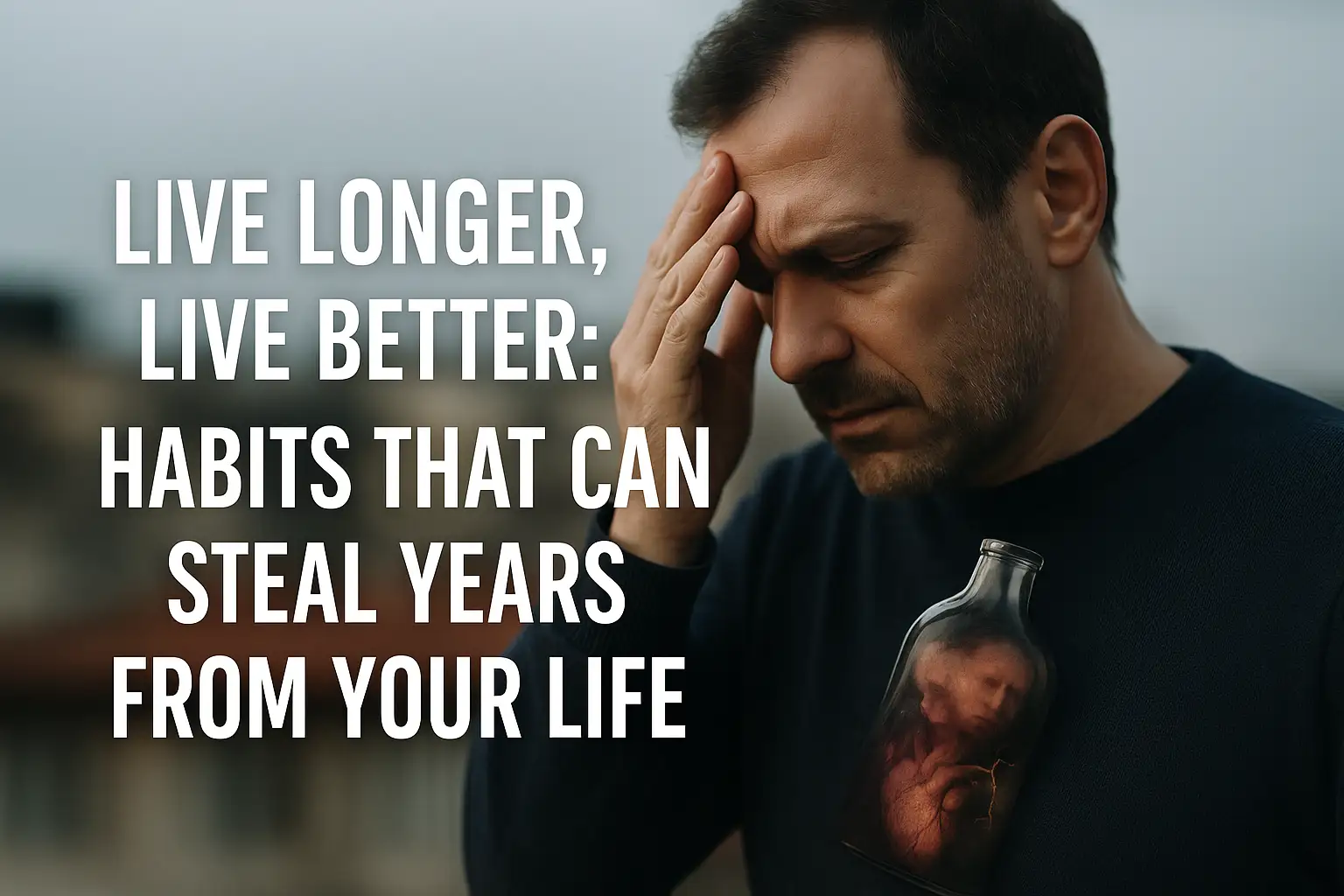The desire to live longer is a fundamental human aspiration, deeply intertwined with our hope for more time to experience joy, connection, and purpose. Yet, many of us operate under a quiet assumption that our lifespan is a pre-written script, dictated largely by the genetic lottery of our family history. What if that wasn’t the case? What if the single most significant factor determining how long and how well you live was not out of your control, but was instead shaped by the countless small choices you make every single day?
Groundbreaking research confirms this empowering truth: while genetics set the stage, they are not the sole director of your health narrative. In fact, only about 25% of human longevity is genetically determined. The remaining 75% is powerfully influenced by your lifestyle, environment, and—most importantly—your habits. This means that the potential to add vibrant, healthy years to your life is overwhelmingly in your hands. The challenge, however, is that many of the habits that silently steal these years are deeply ingrained, often mistaken as harmless, or hidden in the convenience of modern life. They don’t announce their danger with immediate consequences; instead, they chip away at your vitality gradually, shortening your healthspan and ultimately, your lifespan.
The profound good news is that by bringing these habits into the light, you can disarm them. This isn’t about a complete life overhaul overnight; it’s about awareness, understanding, and taking purposeful, manageable steps toward change. By recognizing and reforming these behaviors, you aren’t just investing in a longer life—you are committing to a better one, filled with more energy, resilience, and joy. Let’s uncover these common thieves of time and explore how you can reclaim every precious year.
1. The Standard American Diet: Fueling Disease
- Often abbreviated as SAD, the Standard American Diet is ironically named for its devastating effects on our collective health. It’s not merely a poor choice; it’s a primary driver of the chronic disease epidemic, acting like a slow-burning fire that damages the body from within and silently steals years of vitality from your life.
- Why It Steals Years: The Mechanisms of harm
- The danger of the SAD lies in its composition and its impact on our biology. It’s characterized by an overconsumption of:
- Ultra-Processed Foods: These are not simply processed items like cheese or canned beans. Ultra-processed foods are industrial formulations, often containing little to no whole foods. They are typically loaded with refined sugars (high-fructose corn syrup, sucrose), unhealthy fats (trans and saturated fats from hydrogenated oils), excessive sodium, and a cocktail of artificial additives, preservatives, and flavor enhancers designed to be hyper-palatable and addictive.
- This chemical concoction wreaks havoc on the body through several key mechanisms:
- Chronic Inflammation: These foods trigger a constant, low-grade alarm in your immune system. Refined sugars and certain fats promote the release of inflammatory messengers (cytokines). This state of chronic inflammation is now recognized as a root cause of most modern diseases, from arthritis to Alzheimer’s.
- Metabolic Dysregulation: A constant influx of simple sugars and refined carbohydrates forces your pancreas to pump out excessive insulin. Over time, this leads to insulin resistance, a precursor to type 2 diabetes. This metabolic chaos also promotes the storage of dangerous visceral fat around your organs.
- Gut Microbiome Damage: Your gut is home to trillions of bacteria crucial for health. The SAD starves beneficial bacteria (which thrive on fiber) and feeds harmful ones (which thrive on sugar). This imbalance (dysbiosis) is linked to a weakened immune system, mood disorders, and digestive issues.
- Oxidative Stress and Cellular Damage: Processed foods generate free radicals, unstable molecules that damage cells, proteins, and even your DNA. This oxidative stress accelerates aging and increases cancer risk.
- Direct Physical Damage: Excessive sodium intake stiffens and damages blood vessel walls, leading to high blood pressure. Unhealthy fats contribute to plaque buildup (atherosclerosis), narrowing arteries and raising the risk of heart attacks and strokes.
- The result is a drastically elevated risk for the world’s leading killers: heart disease, stroke, type 2 diabetes, and certain cancers. It’s crucial to understand that this isn’t just about “getting fat.” Even individuals at a “normal” weight can suffer from metabolic dysfunction and inflammation due to a poor diet, making this a universal threat.
- What to Do Instead: Building a Lifelong Dietary Pattern for Longevity
- Shifting away from the SAD isn’t about embarking on a short-term, restrictive “diet.” It’s about adopting a sustainable, nourishing dietary pattern that becomes your new normal.
- Embrace a Whole-Foods, Plant-Forward Plate: Make plants the star of your meals. Aim to fill half your plate with a colorful array of non-starchy vegetables and fruits (the more colors, the wider the range of protective antioxidants and phytonutrients). A quarter of your plate should consist of lean proteins (chicken, fish, beans, lentils, tofu). The final quarter can be high-fiber whole grains (quinoa, brown rice, oats) or starchy vegetables (sweet potato, squash).
- Read Labels and Identify Culprits: Become a savvy shopper. If a product has a long list of ingredients, especially ones you can’t pronounce, or if sugar (in its many forms: sucrose, dextrose, syrup, etc.) is one of the first three ingredients, consider it a occasional treat, not a staple.
- Practical, Manageable Shifts to Start Today:
2. Smoking: The Arch-Nemesis of Longevity
- Why it steals years: This is the single greatest preventable cause of death. Smoking damages nearly every organ in your body, shaving an average of 10 years off life expectancy. It causes cancers, chronic obstructive pulmonary disease (COPD), and heart disease by inflaming arteries and promoting blood clots.
- What to do instead: Quit. Full stop. The body’s ability to heal is remarkable. Within 20 minutes, your heart rate drops. Within a year, your risk of heart disease is halved. Seek support—it’s a journey, not a solo mission. Use nicotine replacement therapy, prescription medications, counseling, or apps like Smoke Free. Every cigarette you don’t smoke is a victory.
3. A Sedentary Life: Sitting is the New Smoking
- Why it steals years: prolonged sitting slows your metabolism, impairs blood sugar regulation, increases blood pressure, and leads to muscle degeneration. Studies show that excessive sedentary time is independently linked to higher mortality from all causes, even if you exercise.
- What to do instead: Combat stillness with constant, low-grade movement. Aim for 150 minutes of moderate exercise per week, but also break up sitting every 30 minutes. Set a timer to stand, stretch, or walk for 2-3 minutes. Take phone calls while walking, use a standing desk, or park farther away. Consistency trumps intensity.
4. Chronic Anger and Grudges: Poison You Brew Yourself
- Holding onto anger and nurturing grudges is often likened to drinking poison and expecting the other person to get sick. This powerful metaphor underscores a brutal truth: the person most harmed by chronic anger is you. While a fleeting moment of anger is a normal human response, clinging to it transforms a natural emotion into a slow, insidious toxin that erodes your physical health and steals years from your life.
- Why It Steals Years: The Physiology of a Grudge
- When you rehearse a grievance or dwell on an injustice, your brain cannot tell the difference between the original event and the memory you’re reliving. Each time you revisit the anger, it triggers your body’s primal fight-or-flight response, designed for short-term survival, not a perpetual state of being.
- This response floods your system with stress hormones, primarily cortisol and adrenaline. In small, acute doses, these hormones are life-saving. But when released chronically due to persistent anger, they wreak havoc:
- Cardiovascular Damage: Constant adrenaline surges increase your heart rate and blood pressure, forcing your heart to work overtime. Cortisol contributes to the inflammation and damage of the lining of your blood vessels. This one-two punch significantly raises your risk of hypertension, heart attacks, and strokes.
- Weakened Immune System: Cortisol suppresses the immune system’s effectiveness. Over time, this leaves you more vulnerable to infections, slows wound healing, and may even reduce the efficacy of vaccines.
- Accelerated Cellular Aging: Chronic stress and anger are linked to the shortening of telomeres—the protective caps on the ends of your chromosomes. Shorter telomeres are a marker of accelerated biological aging, meaning your cells age faster than your chronological years would suggest.
- Neurological and Psychological Toll: This state of hyper-arousal can disrupt sleep, impair memory and concentration, and deplete feel-good neurotransmitters like serotonin. This creates a vicious cycle, fueling anxiety, depression, and making it harder to break free from negative thought patterns.
- In essence, holding a grudge is a form of chronic psychological stress that manifests as tangible, physical wear and tear, directly shortening your healthspan and lifespan.
- What to Do Instead: The Art of Release and Reclamation
- Letting go of anger is not about excusing the wrongs of others or becoming passive. It is a radical act of self-preservation and self-respect. You are choosing to disarm the poison in your own system. It is about prioritizing your health and peace over the need to hold onto the pain.
- Here are concrete strategies to practice the art of release:
- Acknowledge and Name the Emotion: Don’t suppress the anger. Instead of saying “I am angry,” try saying “I am feeling anger.” This creates a small but critical distance, allowing you to observe the emotion rather than be consumed by it.
- Engage Your Body’s Relaxation Response:
- The 4-7-8 Breathing Technique: This is a powerful tool to short-circuit the stress response. Inhale quietly through your nose for 4 seconds. Hold your breath for 7 seconds. Exhale completely through your mouth, making a whoosh sound, for 8 seconds. Repeat 3-4 times. This activates your parasympathetic nervous system, calming your body directly.
- Progressive Muscle Relaxation: Tense and then release each muscle group in your body, starting from your toes and working up to your head. This helps release the physical tension that anger creates.
- Cognitive Reframing through Journaling: Write it out, but with a purpose.
- Vent Pages: First, dump all your raw, unfiltered thoughts onto paper to get them out of your head.
- The Reframe: Then, ask yourself: “What story am I telling myself about this event? Is this story serving me? Is there another way to look at this situation?” This helps break the cycle of repetitive, angry thoughts.
- Practice Perspective-Taking (Not Forgiving): Try to see the situation from the other person’s perspective. This is not to justify their actions, but to understand that their behavior often stems from their own pain, insecurity, or ignorance. Understanding can dissolve resentment.
- Channel the Energy: Anger is energy. Instead of letting it corrode you from the inside, redirect it. Use it as fuel for a intense workout, to clean your house vigorously, or to passionately engage in a cause you care about. Transform destructive energy into constructive action.
- Seek Professional Guidance: If anger feels unmanageable or rooted in deep trauma, talking to a therapist is one of the strongest steps you can take. Cognitive Behavioral Therapy (CBT) is particularly effective at identifying and changing the thought patterns that fuel chronic anger.

5. Social Isolation: The Loneliness Epidemic
- Why it steals years: Humans are wired for connection. Loneliness and social isolation are associated with a 29% increased risk of heart disease and a 32% increased risk of stroke. It can be as damaging to lifespan as smoking 15 cigarettes a day, triggering inflammation and unhealthy behaviors.
- What to do instead: Be intentional about connection. Nurture existing relationships with regular calls or walks. Create new ones by joining a club, volunteering, taking a class, or participating in community events. Quality matters more than quantity—a few deep, trusted relationships are incredibly protective.
6. The Perfection Paradox: Why “All or Nothing” Fails
- Why it steals years: This mindset convinces us that if we can’t do a full hour at the gym or eat perfectly clean 100% of the time, it’s not worth doing at all. This leads to cycles of guilt, failure, and abandonment of healthy goals.
- What to do instead: Embrace the “1% better” rule. Tiny, sustainable changes compound into remarkable results over time. One extra glass of water today, a 10-minute walk tomorrow, choosing brown rice over white on Wednesday—it all counts. Progress, not perfection, is the goal.
7. Avoiding the Doctor: The High Cost of “Wait and See”
- Why it steals years: Ignoring symptoms or skipping preventive screenings allows manageable conditions like hypertension, high cholesterol, or prediabetes to develop into full-blown, life-threatening diseases like heart attacks, strokes, or cancer.
- What to do instead: Be the CEO of your health. Schedule your annual check-ups and age-appropriate screenings (mammograms, colonoscopies, etc.). Keep a list of questions for your doctor. Early detection is the closest thing we have to a superpower against disease.
8. Compromising Sleep: Shortchanging Your Recovery
- Why it steals years: During sleep, your body repairs cells, clears toxins from the brain, and consolidates memories. Consistently getting less than 7 hours is linked to a weakened immune system, weight gain, depression, and a higher risk of cardiovascular disease and dementia.
- What to do instead: Prioritize sleep hygiene. Make your bedroom a dark, cool, tech-free sanctuary. Establish a relaxing wind-down routine an hour before bed (read a book, take a bath, practice light stretches). Go to bed and wake up at consistent times, even on weekends.

9. Unmanaged Stress: The Silent Accelerator of Aging
- Why it steals years: Chronic stress shortens telomeres—the protective caps on our chromosomes that are a key marker of biological aging. This leads to accelerated aging at a cellular level, a weaker immune response, and higher inflammation.
- What to do instead: Build a “stress-resilience toolkit.” Find what helps you decompress and practice it daily. This could be 10 minutes of meditation (try apps like Calm or Headspace), a yoga class, spending time in nature, or engaging in a hobby that puts you in a state of “flow.”
10. Genetic Determinism: Surrendering Your Power
- Why it steals years: Believing “it’s all in my genes” is a self-fulfilling prophecy that leads to passive neglect. It absolves us of the responsibility to make healthy choices, robbing us of our agency and the 75% of longevity factors we can influence.
- What to do instead: Adopt a mindset of possibility and control. Your genes may load the gun, but your lifestyle pulls the trigger. Focus relentlessly on the factors within your command: your nutrition, your movement, your sleep, and your mindset. This is where your power lies.
Key Takeaways for Your Longevity Journey
- You Hold the Pen: Your daily choices are the primary author of your health story.
- Start Small, Think Long: Don’t overhaul your life overnight. Choose one habit to focus on for a month. Master it, then add another.
- Consistency Over Intensity: A five-minute daily walk is better than a monthly marathon you dread.
- It’s Holistic: Longevity isn’t just physical. It’s deeply connected to your mental, emotional, and social well-being.
Final Thought: The best time to plant a tree was 20 years ago. The second-best time is now. You can’t change the years behind you, but you can profoundly influence the years ahead. Begin today. Your future, more vibrant self will thank you for it.
FAQ
1. How much control do I really have over how long I live?
You have significant control. While about 25% of longevity is influenced by genetics, a full 75% is determined by lifestyle, environment, and habits. This means your daily choices are the most powerful factor in shaping both your lifespan and your “healthspan”—the number of years you live in good health.
2. What’s so bad about the “Standard American Diet” (SAD), and what should I eat instead?
The SAD is high in ultra-processed foods, refined sugars, and unhealthy fats. It harms the body by causing chronic inflammation, metabolic problems (like insulin resistance), and damage to your gut microbiome. These are root causes of heart disease, stroke, type 2 diabetes, and some cancers.
Instead of a short-term diet, build a sustainable pattern:
- Follow a “plant-forward” plate: Fill half your plate with colorful vegetables and fruits, a quarter with lean protein, and a quarter with whole grains or starchy vegetables.
- Read labels: Be wary of long ingredient lists or sugars listed in the top three items.
3. Is it really worth quitting smoking if I’ve smoked for years?
Yes, absolutely. Quitting is the single best thing you can do for your longevity. Your body begins to heal quickly. Your heart rate drops within 20 minutes, and your risk of heart disease is cut in half within a year. Support (like apps, counseling, or nicotine therapy) can make the journey easier—every cigarette you don’t smoke is a victory.
4. I exercise a few times a week, but I have a desk job. Is that still harmful?
Yes, prolonged sitting is an independent risk factor, even if you exercise. Sitting for long periods slows your metabolism and impairs blood sugar regulation.
The key is to combat constant stillness:
- Aim for 150 minutes of moderate exercise per week.
- Break up sitting every 30 minutes. Stand, stretch, or walk for 2-3 minutes—set a timer as a reminder.
5. How can holding a grudge actually affect my physical health?
Chronic anger keeps your body in a prolonged “fight-or-flight” state, flooding it with stress hormones like cortisol. This leads to high blood pressure, a weakened immune system, and even accelerated cellular aging by shortening your telomeres (protective caps on chromosomes).
Letting go is an act of self-preservation. Strategies include:
- 4-7-8 breathing to calm your nervous system.
- Journaling to reframe your thoughts.
- Channeling the energy into exercise or a constructive project.
6. Can feeling lonely really shorten my life?
Yes. Strong research links loneliness and social isolation to a significantly increased risk of heart disease and stroke, with a health risk comparable to smoking 15 cigarettes a day. Humans are biologically wired for connection.
Focus on quality over quantity. Nurture a few deep relationships and be intentional about making connections through activities like joining a club, volunteering, or taking a class.
7. Why does aiming for “perfect” healthy habits often backfire?
The “all or nothing” mindset sets you up for failure. If you miss one workout or eat one “bad” meal, the guilt can make you abandon your goals entirely.
Instead, embrace the “1% better” rule. Small, sustainable changes—like an extra glass of water, a 10-minute walk, or choosing whole grains—compound into major results over time. Consistency with imperfection beats short-term perfection.
8. Why are regular doctor visits so important if I feel fine?
Many serious diseases start silently. Skipping preventive screenings for conditions like high blood pressure, high cholesterol, or prediabetes allows them to progress into full-blown heart disease, stroke, or cancer.
Be the CEO of your health: schedule annual check-ups and age-appropriate screenings (like mammograms or colonoscopies). Early detection is one of the most powerful tools for a long life.
9. What happens to my body if I don’t get enough sleep regularly?
Sleep is when your body performs critical repair. Consistently shortchanging sleep disrupts cellular repair, the brain’s toxin-clearance process, and hormonal balance. This increases the risk for numerous chronic diseases and accelerates aging.
Prioritize 7-9 hours per night and maintain a consistent sleep schedule and relaxing bedtime routine.
Ressources
Nutrition & Healthy Eating
- Harvard T.H. Chan School of Public Health: The Nutrition Source
A definitive, science-backed guide to building a healthy diet, debunking myths, and understanding food research.
Link: https://www.hsph.harvard.edu/nutritionsource/ - American Heart Association: Healthy Cooking Tips
Practical advice on how to prepare meals that are good for your heart, including recipes and shopping guides.
Link: https://www.heart.org/en/healthy-living/healthy-eating/cooking-skills
Quitting Smoking & Tobacco
- World Health Organization (WHO): Quitting Toolkit
A comprehensive resource with information on different cessation methods and strategies.
Link: https://www.who.int/campaigns/world-no-tobacco-day/wntd-2021/quit-tobacco-toolkit - Smokefree.gov (U.S. Department of Health & Human Services)
Provides free, evidence-based information and tools, including apps, text message programs, and a quit plan.
Link: https://smokefree.gov/
Physical Activity & Reducing Sedentary Time
- Centers for Disease Control and Prevention (CDC): Physical Activity Guidelines
Outlines the recommended amounts and types of activity for all age groups for optimal health.
Link: https://www.cdc.gov/physicalactivity/basics/index.htm
Mental Health, Stress & Anger Management
- American Psychological Association: Anger Control
Offers strategies for understanding and managing anger in healthy ways.
Link: https://www.apa.org/topics/anger/control - Mindful.org: Guided Meditations
A fantastic portal for beginners to learn about mindfulness and access free guided meditations.
Link: https://www.mindful.org/meditation/mindfulness-getting-started/ - Psychology Today Therapist Directory
A widely used tool to find licensed therapists and counselors in your local area or for online sessions.
Link: https://www.psychologytoday.com/us/therapists
Sleep Hygiene
- National Sleep Foundation: Healthy Sleep Tips
Provides extensive resources on improving sleep hygiene, understanding sleep disorders, and creating an ideal sleep environment.
Link: https://www.thensf.org/healthy-sleep-tips/
General Longevity & Preventive Health
- National Institute on Aging: Health & Longevity
Research-based articles and tips on healthy aging, covering everything from diet and exercise to cognitive health.
Link: https://www.nia.nih.gov/health/healthy-aging - CDC: Preventive Health Guidelines
Guidelines on screenings and immunizations by age and gender, a key resource for proactive healthcare.
Link: https://www.cdc.gov/prevention/index.html
About the author
Max Wild is a health writer and researcher focused on cancer awareness, prevention, and patient education. He translates complex medical topics into simple, practical guidance so readers can have more informed conversations with their doctors.


1 thought on “Live Longer, Live Better: Habits That Can Steal Years From Your Life”